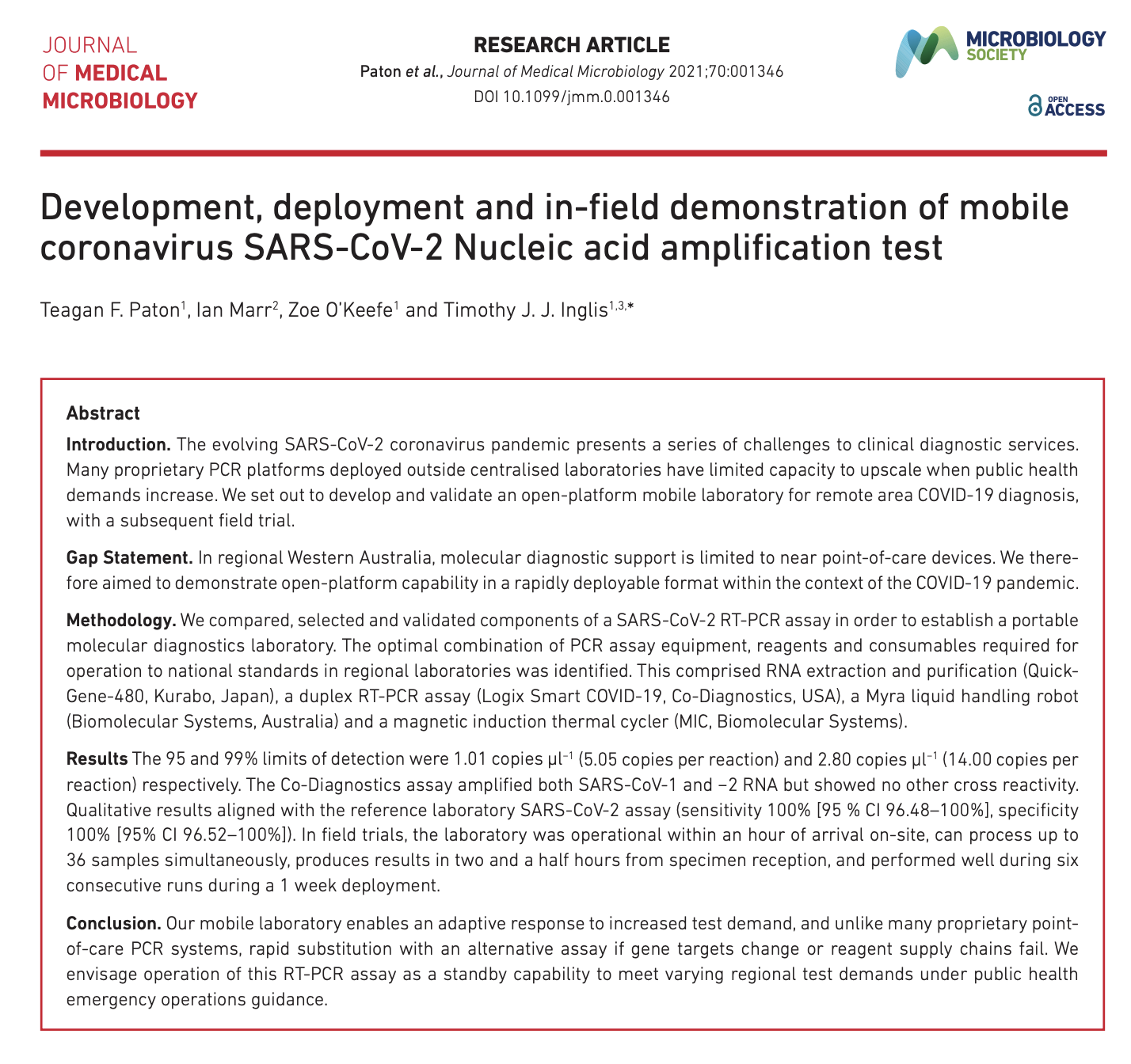
- April 21, 2021
Development, deployment and in-field demonstration of mobile coronavirus SARS-CoV-2 Nucleic acid amplification test
Teagan F. Paton, Ian Marr, Xoe O’Keefe and Timothy J.J. Inglis, Department of Microbiology, PathWest Laboratory Medicine WA, Queen Elizabeth II Medical Centre, Nedlands 6009, WA, Western Australia, Australia; Menzies School of Health, National Health Laboratory, Dill, Timor-Leste; Schools of Medicine and Biomedical Sciences, the university of Western Australia, Crawley 6009 WA, Australia|Journal of Medical Biology|2021|70:001346 DOI 10.1099/jmm.0.001346
The ever-evolving SARS-CoV-2 coronavirus pandemic has challenged the centralised, reference laboratory service model as its slow diagnostic turnaround times can hinder important public health responses. The rapidly expanding pandemic has called for alternatives solutions that enable remote diagnostic testing whilst still maintaining high sensitivity and specificity. The current gold-standard method for the diagnostic detection of COVID-19 is RT-qPCR as it is highly sensitive and specific, however majority of workflows require bulky devices that cannot be easily deployable.
This study set out to develop and validate an open-platform mobile laboratory for remote COVID-19 diagnosis using the gold-standard RT-qPCR. A robust, compact and portable testing schema was developed that included QuickGene Tissue II RNA Kit using QuickGene Mini-480 pressure manifold for RNA extraction, Logix Smart COVID-19 duplex RT-PCR as the RT-qPCR assay, MYRA Liquid Handling robot for automation of sample processing and Magnetic Induction Cycler (MIC) as the qPCR machine. These components were selected on their portability as they have small footprints and lower price-points whilst still being a reliable, safe and highly sensitive molecular diagnostic workflow. As the workflow can be established within one hour of deployment there is an immediate increase in testing capacity, from four patient samples to 150 samples per day.
The overall time it takes from RNA extraction to result is just over 2 hours (20 minutes for RNA extraction, 10 minutes sample processing and 1.5 hours for RT-qPCR). The Logix Smart COVID-19 duplex RT-PCR reaction setup consists of 5 µL of master mix with 5 µL of template and was prepared using the MYRA in this study. The limit of detection of the deployable workflow was determined by performing RT-qPCR on 20 replicates of SARS-CoV-2 RNA standard using 10-fold dilution from 10-3 to 10-9. The researchers demonstrated an analytical sensitivity of 1010 viral copies/mL, which they found to be comparable to other tests used in centralised settings. The week-long field trial undertaken, where nasopharyngeal swabs were obtained from patients and split for parallel testing by PathWest using their internally validated PathWest SARS-CoV-2 IHD-RT-PCR assay, showed that the sensitivity and specificity of the deployable workflow had complete concord to the PathWest assay.
One of the limitations for regional deployment is the cold chain storage of reagents. It was found that even though the containers did not exceed the temperature control failure threshold of 10°C there was some partial thawing of reagents, which can contribute to variable assay performance. The study suggested that as degradation was observed, the threshold limits should be revised and when transit times exceed 1-2 hours that strengthening of cold chain methods is required, particularly in hot climates. Alternatively, reagents that have been lyophilised could be used as they do not require cold chain storage.
In conclusion, by opting for an open molecular diagnostic platform like the one developed, it allows flexible throughput and the ability to validate and change assays simply as they are not depended on dedicated proprietary test kits. It also allows for the components to further be used beyond the life of the current pandemic. By incorporating small footprint devices, such as the MIC and MYRA, it allows diagnostic testing to be deployable while still maintaining accuracy and reliability. By going to the source rather than staying at centralised locations, it can provide optimal sample integrity with less need to factor in transport time or temperature variations during transport and reduce the turn-around time from sample to result to allow for faster public health responses to be made.